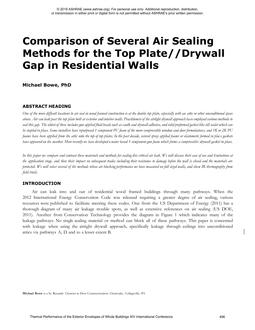Description
One of the more difficult locations to air seal in wood framed construction is at the double top plate, especially with an attic or other unconditioned space above. Air can leak past the top plate both at exterior and interior walls. Practitioners of the airtight drywall approach have employed various methods to seal this gap. The oldest of these includes gun applied fluid beads such as caulk and drywall adhesive, and solid preformed gasket like sill sealer which can be stapled in place. Some installers have repurposed 1 component PU foam of the more compressible window and door formulations, and 1K or 2K PU foams have been applied from the attic onto the top of top plates. In the past decade, several spray applied foams or elastomeric formed in plac e gaskets have appeared on the market. More recently we have developed a water based 1 component gun foam which forms a compressible drywall gasket in place. In this paper we compare and contrast these materials and methods for sealing this critical air leak. We will discuss their ease of use and limitations at the application stage, and then their impact on subsequent trades including their resistance to damage before the wall is closed and the materials are protected. We will select several of the methods whose air blocking performance we have measured on full sized walls, and show IR thermography from field trials.
Citation: Thermal Buildings XIV 2019
Product Details
- Published:
- 2019
- Number of Pages:
- 11
- Units of Measure:
- Dual
- File Size:
- 1 file , 1.1 MB
- Product Code(s):
- D-Bldgs19-054




